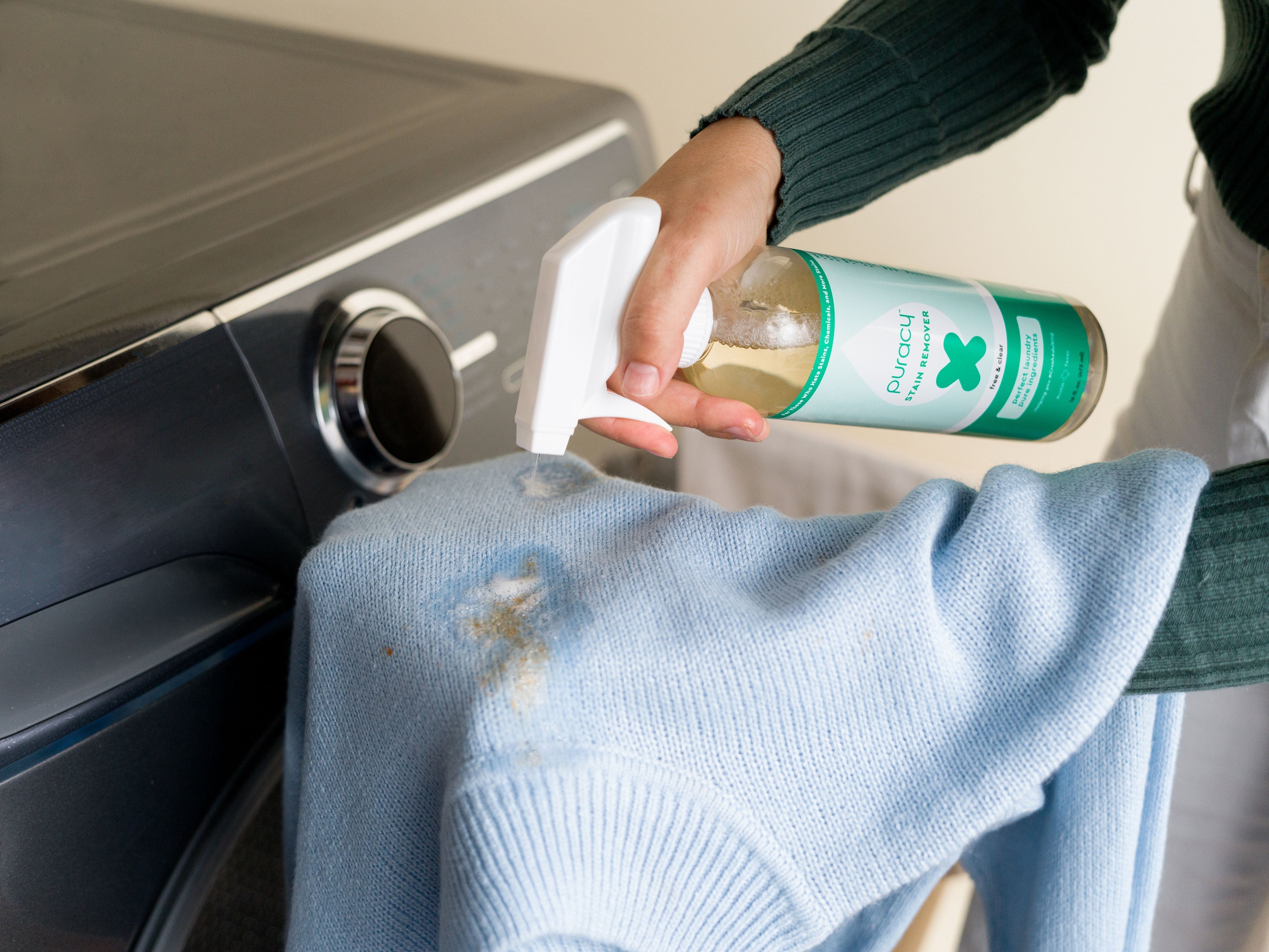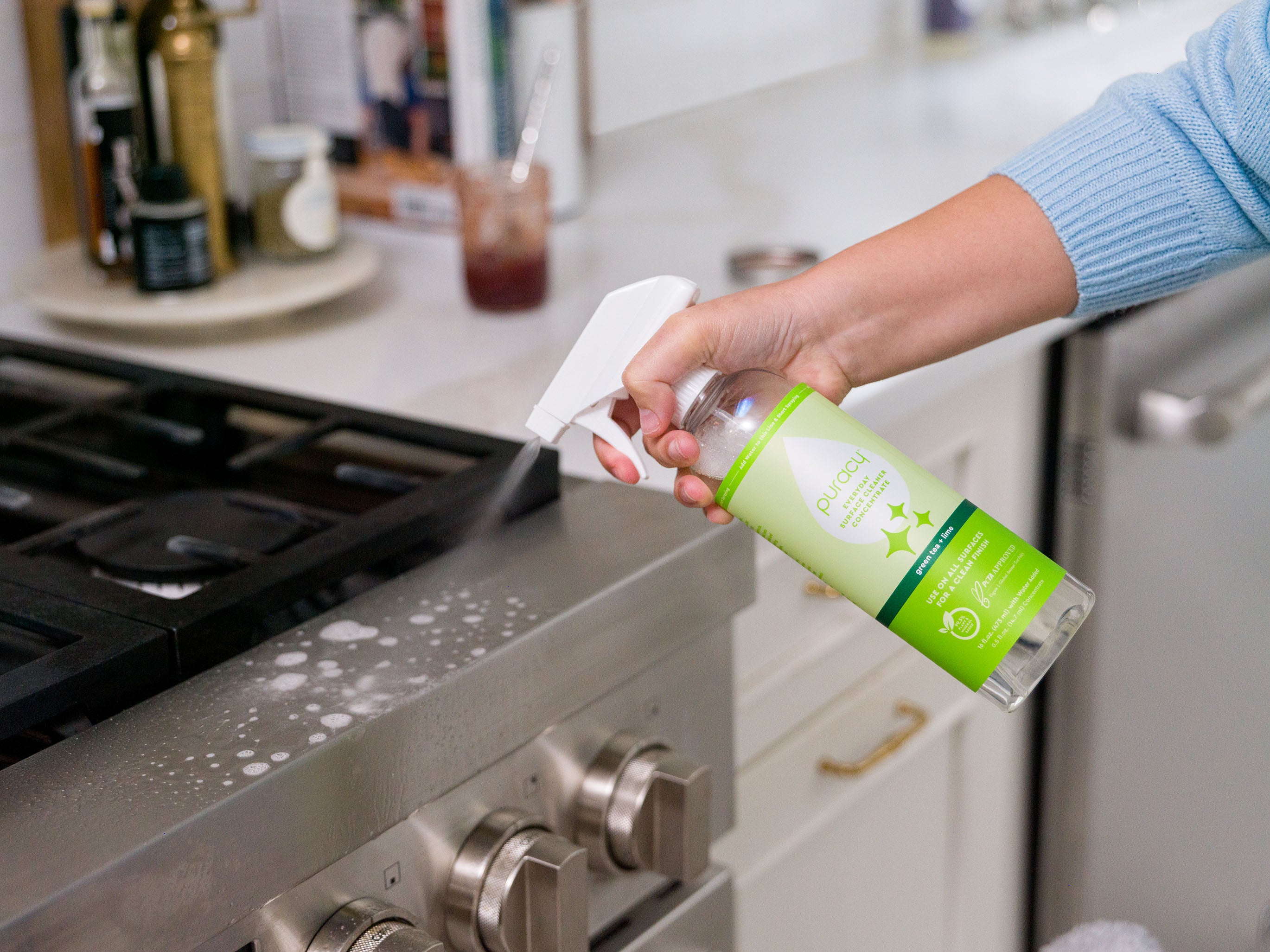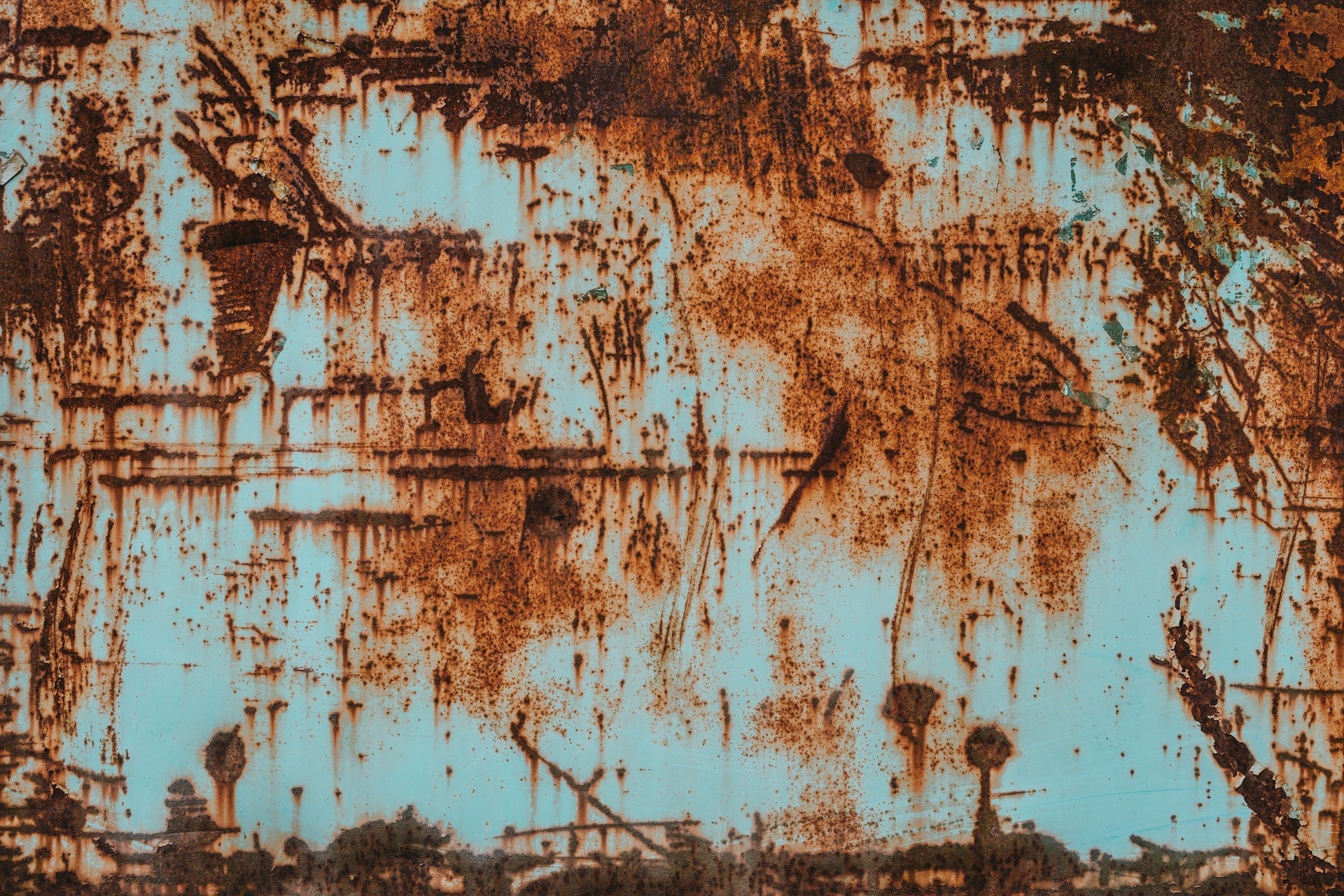
The Ultimate Guide to Removing Stains
When it comes to knowing how to remove stains from clothes, it can be overwhelming navigating different types of stains and fabrics. We've got you covered with our ultimate guide to removing different blemishes, from food and drink stains to grass and sweat stains.
A Few Stain Removal Tips to Keep in Mind

Before tackling a particular stain don’t forget to check these factors beforehand.
- Follow Fabric Care Instructions: Refer to these instructions to ensure delicate fabrics are treated correctly.
- Water temperature: Cold water generally works for protein-based stains such as blood, urine, or paint. Delicate fabrics like wool, satin, or silk should also be treated with cold water. Hot water is best for oil-based stains such as chocolate, makeup, or wine.
- Do Not Put Clothes in Dryer Until Stain is Completely Lifted: Apply your stain treatment before placing the item in the washer for best results. Once a stained piece of clothing has been washed and dried, the stain is more difficult to remove.
- Pre-Test to Avoid Bigger Stains: If you're not sure how a fabric will take a stain solution, try it out on a small corner of the clothing first to determine colorfastness.

Whether you’re dealing with barbecue sauce and chocolate or lipstick and wine, our tips will have blemished clothing back to looking their best.
Beverage Stains
Baby Formula

- Dampen with cold water.
- Place 1 tbsp of laundry detergent onto clean cloth.
- Gently rub the detergent on mark; allow to sit for 10 minutes.
- Spray on Natural Baby Stain Remover.
- Wash item according to fabric care instructions.
Coffee

- Rinse with cold water.
- Spray on Stain Remover; allow to sit for 20 minutes.
- Wash item according to fabric care instructions.
- Repeat steps 1-3 as necessary.
Juice

- Dilute stain with cold water.
- Saturate with Stain Remover; let sit for 15 minutes, or up to 8 hours for older stains.
- Wash item according to fabric care instructions.
- Repeat steps 1-3 as necessary.
Pro tip: When it comes to cranberry juice stains, hydrogen peroxide can be applied to the stain for best results.
Milk

- Blot excess milk with clean cloth.
- Mix 2 cups cold water, 1 tbsp baking soda, and 1 tbsp dish soap.
- Gentle rub mixture on stain using an old toothbrush. Rinse with cold water.
- Spray on Stain Remover; let sit for 15 minutes, or up to 8 hours for older stains.
- Wash item according to fabric care instructions.
Soda

- Blot excess soda with clean cloth.
- Spray on Stain Remover; let sit for 15 minutes, or up to 8 hours for older stains.
- Wash item according to fabric care instructions.
Tea

- Blot excess tea with clean cloth.
- Dab white vinegar on the affected area; let sit for up to 30 minutes.
- Spray on Stain Remover; let sit for 15 minutes, or up to 8 hours for older stains.
- Wash item according to fabric care instructions.
Wine

- Blot excess wine with clean cloth.
- Spray on Stain Remover; let sit for 15 minutes, or up to 8 hours for older stains.
- Wash item according to fabric care instructions.
- Repeat steps 1-3 as necessary.
See more steps to remove wine.
Body Fluid Stains
Blood

- Completely saturate blemish using Stain Remover.
- Gently rub formula into fabric with old toothbrush.
- Let sit for up to 15 minutes.
- Wash item according to fabric care instructions.
- Repeat steps 1-4 as necessary.
See more steps to remove blood.
Sweat

- Create thin paste of water and baking soda and apply to the affected area.
- Let set for 30 minutes or until completely dry; occasionally gently rub it with old toothbrush.
- Wash item according to fabric care instructions.
- Repeat steps 1-3 as necessary.
Urine

- For heavy stains, pre-soak item in cold water and 1/2 cup of baking soda.
- Put item in washer and use hottest water setting possible based on fabric care instructions.
- Make sure stain is completely lifted before placing item in the dryer.
See more steps to remove pet urine.
Cosmetics Stains
Deodorant

- Create thin paste of water and baking soda and apply to the affected area.
- Let set for 30 minutes or until completely dry; occasionally gently rub it with old toothbrush.
- Wash item according to fabric care instructions.
- Repeat steps 1-3 as necessary.
Lipstick

- Scrape off excess lipstick with spatula or dull knife.
- Apply 1 tsp of Dish Soap to affected area; let sit for 45 minutes. Do not scrub or agitate.
- Soak item in warm water and drop of dish soap. Let soak for up to an hour or overnight if possible.
- Gently scrub with old toothbrush.
- Wash item according to fabric care instructions.
- Repeat steps 1-5 as necessary.
Nail Polish

- Place towel directly under blemish and dab stain with nail polish remover.
- Saturate the area with Stain Remover, and let it sit for up to 15 minutes.
- Wash item according to fabric care instructions.
- Repeat steps 1-4 as necessary.
Pro tip: If you are using acetone to remove the nail polish, first make sure the fabric does not contain acetate. Acetate, commonly found in vintage fabrics, can be dissolved with acetone.
Perfume

- Soak item in warm water and laundry detergent for 5 minutes.
- Saturate affected area with Stain Remover; let sit for 15 minutes, or up to 8 hours for older stains.
- Wash item according to fabric care instructions.
- Repeat steps 1-3 as necessary.
Discoloration Stains
Collar or Cuff Soil

- Scrape off any remaining material using a dull butter knife.
- Spray affected area using Stain Remover; let sit for 15 minutes, or up to 8 hours for older stains.
- Wash item according to fabric care instructions.
Dye Transfer

- Soak item in warm water; let sit for 1 hour.
- Apply Stain Remover to the affected area; let sit for 15 minutes.
- Wash item according to fabric care instructions.
Pro tip: Though red clothes are usually most associated with dye transfer stains, watch out for new blue jeans as well, which can often bleed dye in the washer.
Tobacco

- Soak item in 1 quart warm water, 1 tbsp white vinegar, 1/2 tsp Dish Soap for 20 minutes.
- Rinse with warm water.
- Spray affected area with Stain Remover; let sit for 15 minutes, or up to 8 hours for older stains.
- Wash item according to fabric care instructions.
Food Stains
Barbecue Sauce

- Create mixture using one part vinegar and two parts water.
- Apply solution with clean cloth; let sit for 15 minutes.
- Dab mark with a damp towel.
- Wash item according to fabric care instructions.
Pro tip: Stains with dark colors, such as barbecue sauce, can be treated by white vinegar, thanks to its acidic ability to break down pigment stains.
Butter

- Scrape off any remaining material using a dull butter knife.
- Saturate affected area with Stain Remover; let sit for 15 minutes, or up to 8 hours for older stains.
- Wash item according to fabric care instructions.
- Repeat steps 1-3 as necessary.
Chocolate

- Scrape off any remaining material using a dull butter knife.
- Run the fabric under cold water to dislodge any remaining chocolate.
- Saturate affected area with Stain Remover; let sit for 15 minutes, or up to 8 hours for older stains.
- Wash item according to fabric care instructions.
- Repeat steps 1-4 as necessary.
See more steps to remove chocolate.
Egg

- Scrape off any remaining material using a dull butter knife.
- Soak item in cold water; gently rub affected area with an old toothbrush.
- Saturate affected area with Stain Remover; let sit for 15 minutes, or up to 8 hours for older stains.
- Wash item according to fabric care instructions.
Fruit

- Scrape off any remaining material using a dull butter knife.
- Make thick paste of 1 tbsp water and 3 tbsp baking soda.
- Spread evenly on the affected area; let dry for 20 minutes.
- Rinse item using warm water.
- Apply a few drops of laundry detergent directly on stain; let sit for 5 minutes.
- Rinse using warm water.
- Saturate affected area with Stain Remover; let sit for 15 minutes, or up to 8 hours for older stains.
- Wash item according to fabric care instructions.
Pro tip: Tannin-based stains need to be lightened, which means you need a natural bleaching agent such as baking soda.
Ice Cream

- Scrape off any remaining material using a dull butter knife.
- Saturate affected area with Stain Remover; let sit for 15 minutes, or up to 8 hours for older stains.
- Wash item according to fabric care instructions.
- Repeat steps 1-4 as necessary.
Pro-tip: Look for an enzyme-based cleaner that features amylase, the best solution for tackling chocolate stains.
Ketchup

- Scrape off any remaining material using a dull butter knife.
- Rinse with cold water.
- Saturate affected area with Stain Remover; let sit for 15 minutes, or up to 8 hours for older stains.
- Wash item according to fabric care instructions.
- Repeat steps 1-4 as necessary.
Pro tip: For tomato-based stains, air drying or line drying clothes is recommended to avoid setting the stain deeper into the fabric.
Maple Syrup

- Scrape off any remaining material using a dull butter knife.
- Make mixture using 1/2 tsp dishwashing detergent, 1 tbsp white vinegar, and 1 quart tepid water. Let item soak for 15 minutes.
- Saturate affected area with Stain Remover; let sit for 15 minutes, or up to 8 hours for older stains.
- Wash item according to fabric care instructions.
- Repeat steps 1-4 as necessary.
Mayonnaise

- Scrape off any remaining material using a dull butter knife.
- Spray affected area Stain Remover, let sit for 15 minutes, or up to 8 hours for older stains.
- Wash item according to fabric care instructions.
- Repeat steps 1-3 as necessary.
Pro tip: The enzyme that fights oil-based stains best is lipase, so make sure it's in your cleaner formula for optimum results.
Mustard

- Scrape off any remaining material using a dull butter knife.
- Rinse with cold water.
- Saturate affected area with Stain Remover; let sit for 15 minutes, or up to 8 hours for older stains.
- Wash item according to fabric care instructions.
- Repeat steps 1-4 as necessary.
Turmeric

- Rinse with cold water.
- Soak item in detergent and cold water for 20 minutes.
- Spray affected area Stain Remover, let sit for 15 minutes, or up to 8 hours for older stains.
- Wash item according to fabric care instructions.
- Repeat steps 1-4 as necessary.
Household Items Stains
Adhesive

- Ensure stain is completely dry.
- Scrape off any remaining material using a dull butter knife.
- Put item in freezer to make stain easier to detatch.
- Spray affected area Stain Remover, let sit for 15 minutes, or up to 8 hours for older stains.
- Wash item according to fabric care instructions.
Candle Wax

- Scrape off any remaining material using a dull butter knife.
- Put item in freezer to make stain easier to detatch.
- Place item between two sheets of blotting paper or unpatterned paper towels. Use iron on lowest non-steam setting; go over mark to remove any remaining wax.
- Spray affected area Stain Remover, let sit for 15 minutes, or up to 8 hours for older stains.
- Wash item according to fabric care instructions.
- Repeat steps 1-5 as necessary.
Pro tip: When ironing the affected area, be sure to use a fresh paper towel or blotting sheet each time to avoid repositioning the stain.
Fabric Softener

- Place item in washer without adding detergent or fabric softener.
- Add 2 cups of white vinegar to the water.
- Run a full cycle.
- Do not place item in the dryer until stain is fully lifted.
Pro tip: If you continue to see fabric softener stains, you may need to dilute the solution to avoid them in the future.
Grease and Oil

- Fully saturate the affected area with enzyme-based Stain Remover.
- Let sit for 15 minutes or up to 8 hours for older stains.
- Wash item according to fabric care instructions.
See more steps to remove grease and oil.
Scorch Marks

- Apply hydrogen peroxide to affected area; let sit for 15 minutes.
- Spray affected area Stain Remover, let sit for 15 minutes, or up to 8 hours for older stains.
- Wash item according to fabric care instructions.
- If mark remains, sprinkle salt and lemon juice directly on stain; dry item in direct sunlight.
Shoe Polish

- Scrape off any remaining material using a dull butter knife.
- Rinse with warm water.
- Spray affected area Stain Remover, let sit for 15 minutes, or up to 8 hours for older stains.
- Wash item according to fabric care instructions.
- Repeat steps 1-4 as necessary.
Ink/Paint Stains
Crayon

- Scrape off any remaining material using a dull butter knife.
- Apply 1 tbsp Dish Soap to affected area; gently rub using old toothbrush.
- Run fabric under warm water.
- Wash the item according to fabric care settings.
Ink

- Remove any excess ink by blotting stain.
- Spray affected area Stain Remover, let sit for 15 minutes, or up to 8 hours for older stains.
- Wash item according to fabric care instructions.
- Repeat steps 1-3 as necessary.
Pro tip: For permanent ink, you can try an alcohol-based soap to break down the oil found in the ink.
Paint

For water-based paint:
- Scrape off any remaining material using a dull butter knife.
- Rinse with warm water.
- Apply laundry detergent directly on stain; let sit for 15 minutes.
- Spray affected area Stain Remover, let sit for 15 minutes, or up to 8 hours for older stains.
- Wash item according to fabric care instructions.
- Repeat steps 1-5 as necessary.
For oil-based paint:
- Place paper towels directly under affected area; apply paint thinner to stain. Allow paint to be absorbed into paper towels.
- Wash item according to fabric care instructions.
Outdoor Stains
Grass

- Spray affected area Stain Remover, let sit for 15 minutes, or up to 8 hours for older stains.
- Gently agitate the area with an old toothbrush or soft bristled brush.
- Wash item according to fabric care instructions.
- Repeat steps 1-3 as necessary.
Mold and Mildew

- Spray affected area with Stain Remover; use soft brush to gently agitate the affected area.
- Let solution soak for up to 8 hours to allow the cleaner to set.
- Wash the item using washer's hottest water setting to kill remaining mold spores.
- Dry clothes using highest heat setting, or alternatively, air dry clothes in direct sunlight.
See more steps to remove mold and mildew.
Mud

- Scrape off any remaining material using a dull butter knife.
- Apply laundry detergent directly to stain; let sit for 15 minutes. Gently rub detergent using old toothbrush.
- Spray affected area Stain Remover, let sit for 15 minutes, or up to 8 hours for older stains.
- Wash item according to fabric care instructions.
- Repeat steps 1-4 as necessary.
Rust

- Sprinkle salt and lemon juice directly on stain; let item completely dry in direct sunlight.
- Spray affected area Stain Remover, let sit for 15 minutes, or up to 8 hours for older stains.
- Wash item according to fabric care instructions.
- Repeat steps 1-3 as necessary.
Pro tip: The lemon juice's acidity helps loosen rust from the fabric and is strengthened by the sun's UV rays.
Tree Sap

- Use a clean cloth or towel to blot any excess sap.
- Spray affected area Stain Remover, let sit for 15 minutes, or up to 8 hours for older stains.
- Wash item according to fabric care instructions.
- Repeat steps 1-3 as necessary.
Pro tip: Rubbing alcohol can also remove tree sap, but use with caution as it can damage delicate fabrics.
Wood Stains

- Apply mineral spirits to affected area with clean cloth, starting from outside of stain towards center.
- Wash item according to fabric care instructions.
- Repeat steps 1-2 as necessary.
When Should I Take Stained Clothing to a Professional?

For delicate fabrics such as wool or silk, fabric care instructions may say it is dry clean only. In that case, a stained item may be best handled by a professional dry cleaner. Fabrics such as cotton can typically take normal food or household stains without requiring a professional, but always consult the fabric care instructions to determine the best solution.
Tackle Blemishes Naturally with Enzyme-Based Ingredients

Whether you're dealing with blood, sweat, wine, or chocolate, our Natural Stain Remover thoroughly tackles the toughest blemishes. Best of all? Our formulas don't contain sulfates, brighteners, salicylates, parabens, or petroleum-based ingredients. That way, we effectively fight tough messes while also being gentle on the most sensitive skin.


























